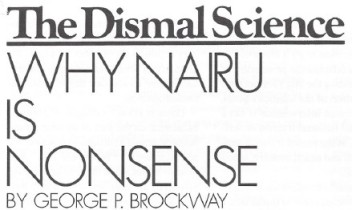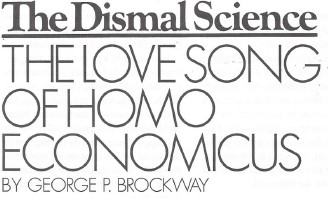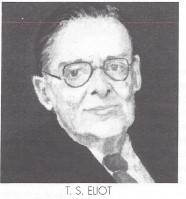By George P. Brockway, originally published May 7, 1999

MANY YEARS AGO, when I was a college undergraduate, there was some talk on campus about The Fountainhead[1], a massive novel by Ayn Rand. I was aware of it because one of my close friends told me a bit about it, and the older brother of a classmate had edited it, but I never read the book nor did I see the movie. Perhaps it was too huge for me (I was reading Ernest Hemingway‘s stories and Gertrude Stein‘s scribblings). Perhaps I was sufficiently law-abiding to be put off by the novel’s intensely self-centered architect hero[2], whose action at the end was the principal topic of what I heard (he destroyed an allegedly supremely beautiful building he had built because the owner wanted some changes).
I never read Atlas Shrugged either, or any of the other works by Ayn Rand, and I was not aware that she was a self- invented economist until I became one myself. Even then I was-and still am-put off by the name she gave to her philosophy (“objectivism“). But despite my ignorance of what she has written, I am prepared to claim that she has had a great and salutary effect on the present and possible prosperity of the United States of America. Maybe of the world.
One of Ayn Rand’s disciples was Alan Greenspan, who grew up to be Chairman of the Federal Reserve Board. So far as I know, Greenspan has never made a public reference to her, and so far as I am aware, only three of her doctrines may have slipped into the proceedings of the august body he heads. He has spoken some odd words on the movement of the price of gold as an indicator of the future course of the price level. His aversion to regulation of the rogue multitrillion-dollar derivatives market may be linked in his mind with the behavior of the hero of The Fountainhead. And almost alone among the public men of our time, he doesn’t believe in the barbarous theory of a natural rate of unemployment.
In any case, I suspect that her influence has been both more profound and more beneficial than her ideas. As a result of his association with her, Greenspan learned how to be at once the consummate insider and the consummate outsider.
Because he is a consummate insider, he got to where he is. Because he is a consummate outsider, he has not been overawed by the high-powered bankers and economists with whom he does business. Because he is not overawed by these worthies, we have not had a boost in the interest rate since March 1994, and in fact had three quarter-of-a -point cuts last summer and fall.
These 60-odd months without a rate increase constitute the longest, indeed the only, period of tranquility the Federal Reserve Board has allowed the American economy in the 30 years since the Reserve launched its all-out war against inflation-which propelled the Consumer Price Index from 36.7 in 1969 to 99.6 in 1984, a record-breaking and stupefying leap of 272 per cent in 14 years. It is for the present period of tranquility (and for its continuance, if he can bring it off) that Greenspan is renowned today and will be forever famous in the annals of economics and of political economy.
There is no doubt that if Greenspan had polled the economics profession and the banking profession he would have had them almost solidly against him. On July 19, 1995, Greenspan said in Congressional testimony, “I don’t believe that any particular unemployment rate-that 5 per cent or 5.5 per cent or whatever numbers we’re dealing with-is something desirable in and of itself. I don’t believe that.”
Neither the New York Times nor the Wall Street Journal reported this testimony (but THE NEW LEADER did, and I have the videotape). As I said at the time, this was earthshaking testimony. It directly contradicted what then was the first or second most sacred economic law, namely the natural rate of unemployment, a.k.a. the nonaccelerating inflation rate of unemployment, a.k.a. NAIRU. It is possible, but not certain, that the ancient “law” of supply and demand had a tighter grip than NAIRU on the hearts and minds of economists and those who pretended to an interest in economics. Yet Greenspan contradicted this barbarous doctrine, and got away with it.
As it happened, the economy jogged along pretty well. The stock market boomed, because the Baby Boomers were worried about saving for retirement and didn’t know where else to put their money. As the market soared, more and more of them made nice killings and began to spend some of their capital gains. Retail sales, especially of automobiles and other big-ticket items, picked up. Unemployment began to fall, and so, to almost everyone’s surprise, did inflation.
After a while the media began looking for someone to give the credit to. President Clinton was willing, but no matter what he claimed, and no matter what photo ops were arranged, people kept saying that he was too preoccupied with impeachment to run the country. Perhaps they were right, and, obviously the Republicans were too preoccupied, for the same reason.
Greenspan was available, and an interview with him was almost as good copy as the stories quoting Casey Stengel used to be. He talked about the free market, so he became the leader of the free world.
Of course, I wasn’t there, but I have a clear picture of what happened next. At meeting after meeting, the Federal Reserve Board staffers brought in sheaves of disturbing figures showing that Wendy’s in Sandusky was having trouble holding dishwashers and hiring cashiers; that Kmart in New Jersey had constant openings for stock clerks; that Boeing in Seattle was looking for riveters. Everywhere, in other words, the unemployment rate was falling-falling steadily below the rate at which all the bankers in the country knew, and all the mainline economists in the country absolutely knew, that inflation definitely had to break out again. The financial press talked nervously of the importance of being ahead of the curve, and Greenspan himself spoke of making a pre-emptive strike against inflation.
Nevertheless, Greenspan has not acted. He tried jawboning the stock market-and quickly learned that his reputation as economic wise man of the Western World was in jeopardy because practically no one was in favor of repeating the 1987 market crash.
Lately he has made a series of speeches suggesting that an increase in the productivity index explains our “miraculous” combination of falling unemployment and falling inflation. Since the productivity index is a fraction (output divided by hours worked), its value rises when the denominator falls. Greater productivity, therefore, is hardly an explanation of increasing employment.
WELL, maybe Greenspan can pull it off, but it would help if he could make clear why NAIRU has not performed as advertised. Since the business and financial press has not been able to do that either, the professional belief in NAIRU has been muted but not stilled. The true believers are prepared to stay the course, because they have been given no reason not to.
We shall continue to live in fear that our tranquil days of steadily expanding prosperity will soon be over unless somebody sets them straight. So, it might as well be me, here and now.
It isn’t enough to remind the believers that not so long ago they insisted the telltale rate of unemployment was 7.0 per cent, then 6.5 per cent, then 6.0 per cent, then 5.5 per cent, then 5.0 per cent, then 4.5 per cent, and now it must be 4.0 per cent or lower. They shrug off this embarrassment with the complaint that the available statistics are imperfect or that, as Humphrey Bogart said when told there were no waters in Casablanca, they were misinformed.
It also is not enough to show them that every one of the nine recessions since World War II has been preceded by boosts in the interest rate. The boosts were said to be necessary to nip inflation in the bud. But in fact inflation accelerated more rapidly after the boosts than before them. Another fact: In all the years since World War II, no matter what the Federal Reserve Board has tried, the price level has fallen only once, and in that year (1955) the interest rate fell too. Again, of course, the statistics are imperfect. And without a coherent theory everything is anecdotal, the diehards argue, as the doctors did when Linus Pauling tried to tell them about Vitamin C.
Yet the reason NAIRU is nonsense is not far to seek. To begin with, the interest rate and the unemployment rate are both percentages, just as apples and oranges are both fruits. Interest is a direct cost or an opportunity cost on both sides of every economic transaction. Labor costs are similarly universal. But interest costs are closely uniform for comparable risks throughout the economy; labor costs vary widely from industry to industry, job to job, locality to locality, and (shamefully) from ethnic group to ethnic group as well as from gender to gender.
The two percentages are so radically different in composition that NAIRU theorists themselves never had a theory of their interaction. All they had were some empirical observations that occasionally made pretty graphs, like the Phillips curve. As with all empirical observations, though, theirs were liable to falsification by events.
The serious recessions of 1974-75 and 1980-82 were certainly falsification enough. But those events were disregarded, perhaps because practitioners of this dismal science tend to believe that dismal outcomes must be true, while relatively happy outcomes (like the present situation) must nurture some occult seeds of their own distraction.
Moreover, a 1 point fall in the unemployment rate causes little more than a 1 point rise in the national wage bill (which itself is only three-fifths of the costs of production), whereas a 1 point rise in the basic interest rate (now 4.75 per cent) eventually results in a drop of about 20 per cent in the purchasing power of money (which is, of course, equivalent to a 20 per cent rise of the price level, or a pretty stiff dose of inflation).
Far more important, the interest hike would produce a 16.7 per cent decline in the borrowing power of money, resulting, as we shall see, in a 33 per cent drop in the value of investments that must be made to keep the capitalist system going. If the interest rate is 5 per cent, $500 will get you a year’s use of $10,000. You can invest that $10,000 in an enterprise of your choice, and, unless you are unwise or unlucky, you will earn back your $500 interest plus a profit to boot and be ready to do more of the same.
But if the rate rises to 6 per cent, you will be able to borrow only $8,333 with your $500. Worse yet, the purchasing power of the $8,333 you borrow will have been reduced 20 per cent; so in the end you will have only $6,667 worth of goods to invest in, compared with the $10,000 worth you would have had before the interest hike.
Any way you look at it, the “punishment” of a 1 per cent increase in the interest rate does not fit the “crime” of a 1 per cent decrease in the unemployment rate.
Federal Reserve Bulletin please copy.
The New Leader
[1] Ed: Not likely as an undergraduate. The author graduated college in 1936. The Fountainhead was published in 1943
[2] Ed: Howard Roark is no more self-centered, say, than Donald Trump…

 The wealthy are not the only ones contributing to this trend. The middle class is the beneficial owner, through what are called “institutions” (especially mutual funds and pension funds and insurance policies), of between one-third and one half of all the shares on the current exchanges. By being funded rather than treated as current expenses, these institutions soak up purchasing power and weaken aggregate demand. The funds’ speculating deprives
The wealthy are not the only ones contributing to this trend. The middle class is the beneficial owner, through what are called “institutions” (especially mutual funds and pension funds and insurance policies), of between one-third and one half of all the shares on the current exchanges. By being funded rather than treated as current expenses, these institutions soak up purchasing power and weaken aggregate demand. The funds’ speculating deprives